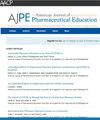Balancing Autonomy and Accountability Through Curricular Flexibility in Pharmacy Education
IF 3.5
4区 教育学
Q1 EDUCATION, SCIENTIFIC DISCIPLINES
引用次数: 0
Abstract
Higher education faces growing calls to rethink traditional approaches to teaching, delivery, and assessment, driven by the evolving needs of modern learners. Today’s students seek education that is flexible, personalized, and closely aligned with their career goals. Curricular flexibility supports learner-centered education, promotes adaptability, and empowers students by shifting some decision-making from faculty to learners. Important nuances must be considered, including the type of flexibility applied and the degree to which learning can be made accessible and adaptable. Literature highlights several benefits, such as fostering self-reflection, promoting engagement, supporting well-being, and encouraging greater accountability for learning. However, barriers exist, including concerns about increased faculty workload, limited direct evidence of positive student outcomes, and the possibility of creating academic entitlement. The purpose of this commentary is to describe elements of curricular flexibility and present examples from higher education and health professions literature that can be implemented at the program level or within individual courses. Successful implementation requires thoughtful consideration of where structure remains essential and where intentional opportunities can be introduced to foster learner accountability and autonomy. Curricular flexibility is not a one-size-fits-all solution, and faculty should assess the feasibility and support provided at the institutional and program levels. Research within pharmacy education is needed to clarify the impact of flexible learning and identify additional ways to overcome the barriers described. By balancing flexibility with academic rigor and professional standards, educators can better prepare learners to work in a society that values autonomy and adaptability and offers multiple paths to success.
通过课程灵活性平衡自主和责任的药学教育。
在现代学习者不断变化的需求的推动下,高等教育面临着越来越多的要求重新思考传统教学、交付和评估方法的呼声。今天的学生寻求灵活的、个性化的、与他们的职业目标密切相关的教育。课程灵活性支持以学习者为中心的教育,促进适应性,并通过将一些决策权从教师转移到学习者手中来赋予学生权力。必须考虑到重要的细微差别,包括所采用的灵活性的类型以及学习可以获得和适应的程度。文献强调了一些好处,如培养自我反思,促进参与,支持福祉,鼓励更大的学习问责制。然而,存在一些障碍,包括对教师工作量增加的担忧,对学生积极成果的直接证据有限,以及可能产生的学术权利。本评论的目的是描述课程灵活性的要素,并从高等教育和卫生专业文献中提出可以在项目层面或在个别课程中实施的例子。成功的实施需要深思熟虑地考虑哪些结构仍然是必不可少的,哪些地方可以引入有意识的机会来培养学习者的责任感和自主性。课程灵活性并不是一种放之四海而皆准的解决方案,教师应该评估在机构和项目层面提供的可行性和支持。需要对药学教育进行研究,以澄清灵活学习的影响,并确定克服上述障碍的其他方法。通过平衡灵活性与学术严谨性和专业标准,教育工作者可以更好地为学习者做好准备,以便在一个重视自主性、适应性和提供多种成功途径的社会中工作。
本文章由计算机程序翻译,如有差异,请以英文原文为准。
求助全文
约1分钟内获得全文
求助全文
来源期刊
CiteScore
4.30
自引率
15.20%
发文量
114
期刊介绍:
The Journal accepts unsolicited manuscripts that have not been published and are not under consideration for publication elsewhere. The Journal only considers material related to pharmaceutical education for publication. Authors must prepare manuscripts to conform to the Journal style (Author Instructions). All manuscripts are subject to peer review and approval by the editor prior to acceptance for publication. Reviewers are assigned by the editor with the advice of the editorial board as needed. Manuscripts are submitted and processed online (Submit a Manuscript) using Editorial Manager, an online manuscript tracking system that facilitates communication between the editorial office, editor, associate editors, reviewers, and authors.
After a manuscript is accepted, it is scheduled for publication in an upcoming issue of the Journal. All manuscripts are formatted and copyedited, and returned to the author for review and approval of the changes. Approximately 2 weeks prior to publication, the author receives an electronic proof of the article for final review and approval. Authors are not assessed page charges for publication.

 求助内容:
求助内容: 应助结果提醒方式:
应助结果提醒方式:


